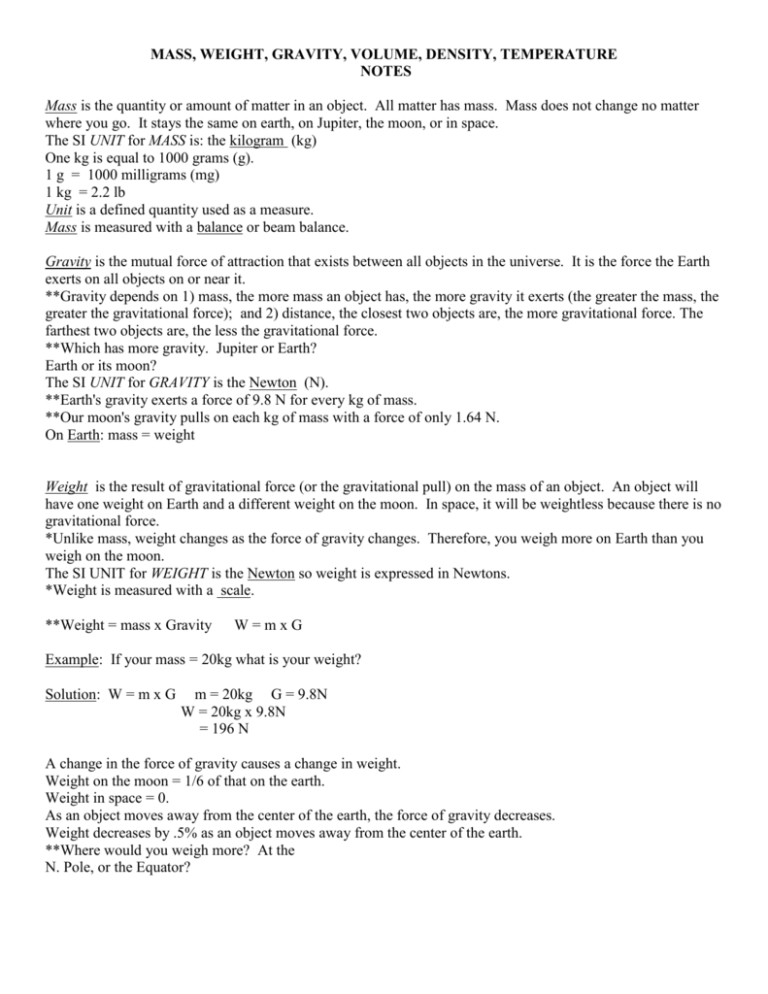Volume is the amount of space taken (occupied) by an object.
advertisement

MASS, WEIGHT, GRAVITY, VOLUME, DENSITY, TEMPERATURE NOTES Mass is the quantity or amount of matter in an object. All matter has mass. Mass does not change no matter where you go. It stays the same on earth, on Jupiter, the moon, or in space. The SI UNIT for MASS is: the kilogram (kg) One kg is equal to 1000 grams (g). 1 g = 1000 milligrams (mg) 1 kg = 2.2 lb Unit is a defined quantity used as a measure. Mass is measured with a balance or beam balance. Gravity is the mutual force of attraction that exists between all objects in the universe. It is the force the Earth exerts on all objects on or near it. **Gravity depends on 1) mass, the more mass an object has, the more gravity it exerts (the greater the mass, the greater the gravitational force); and 2) distance, the closest two objects are, the more gravitational force. The farthest two objects are, the less the gravitational force. **Which has more gravity. Jupiter or Earth? Earth or its moon? The SI UNIT for GRAVITY is the Newton (N). **Earth's gravity exerts a force of 9.8 N for every kg of mass. **Our moon's gravity pulls on each kg of mass with a force of only 1.64 N. On Earth: mass = weight Weight is the result of gravitational force (or the gravitational pull) on the mass of an object. An object will have one weight on Earth and a different weight on the moon. In space, it will be weightless because there is no gravitational force. *Unlike mass, weight changes as the force of gravity changes. Therefore, you weigh more on Earth than you weigh on the moon. The SI UNIT for WEIGHT is the Newton so weight is expressed in Newtons. *Weight is measured with a scale. **Weight = mass x Gravity W=mxG Example: If your mass = 20kg what is your weight? Solution: W = m x G m = 20kg G = 9.8N W = 20kg x 9.8N = 196 N A change in the force of gravity causes a change in weight. Weight on the moon = 1/6 of that on the earth. Weight in space = 0. As an object moves away from the center of the earth, the force of gravity decreases. Weight decreases by .5% as an object moves away from the center of the earth. **Where would you weigh more? At the N. Pole, or the Equator? Volume is the amount of space taken (occupied) by an object. The SI Unit of Volume is the Liter (L). A liter is the same as 1 dm3. 1 cubic meter (1 m3) is equal to 1000 L. *Therefore, 1000 L will fit into a box 1 m long on each side. *A milliliter (mL) will fit into a box 1 cm on each side. So 1 mL = 1 cm3 = 1 cc **To measure liquid volume in the laboratory we use the graduated cylinder for small amounts. **To find the volume of an irregular object we use the displacement method. **To find the volume of a regular shaped object like a cube, a box, or a room you use the meter or centimeter to measure the length of each side and then multiply. V=lxwxh l = length w = width h = height Example: A box has the following dimensions: l = 10cm w = 4cm h = 7cm Find the volume Solution: V = l x w x h V = 10cm x 4cm x 7cm V = 280cm3 Area is a measure of how much surface an object has. Area of a rectangle is length times width. A=lxw Example: The length of your room is 7m and the w is 6m. What is the surface area of the carpet you need? Solution: A = l x w A = 7m x 6m = 28m2 Density is the amount of mass (matter) per unit of volume. For example: A sponge has the same shape and size as a brick but the sponge weighs less than the brick because it has less mass per unit of volume. Its molecules are not as closely packed. Density is a very helpful property when you need to distinguish different substances. *D = m/V The Unit is kg/m3 or g/cm3 *Example: Find the density of a substance with a mass of 4 kg and a volume of 35 m3 *Solution: D = m/V D = 4 : 35 = 0.114 kg/m3 **Derived Quantities: Formed from combinations of other measurements. For example, Area and Density are derived quantities. Temperature: a measure of the kinetic energy (or the speed) of molecules. There are three temperature scales: Kelvin; Celsius; Fahrenheit. *The SI unit for temperature is the Kelvin (K). This scale is based on absolute 0, which is the lowest temperature a gas can reach. This scale is used by scientists and engineers who work with extremely low or high temperatures. The Freezing point is 273.15o and Boiling point is 373.15o on the Kelvin scale. *Scientists in general use degrees Celsius (oC). This scale is divided into 100 degrees between freezing and boiling point and it is also called a Centigrade Scale. Freezing point = 0o C. Boiling point = 100o C. *Fahrenheit is used in the USA. Freezing point of water is 32o F and Boiling point is 212o F. Thermometer is the instrument used to measure temperature.







